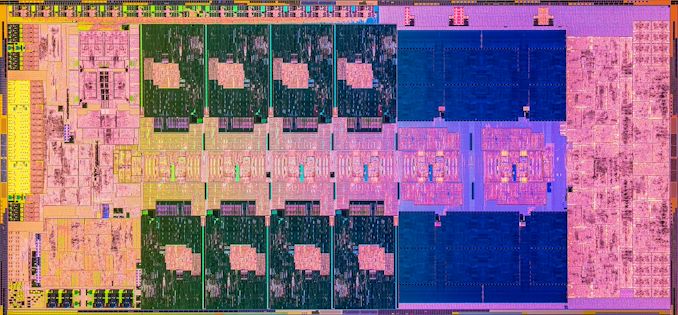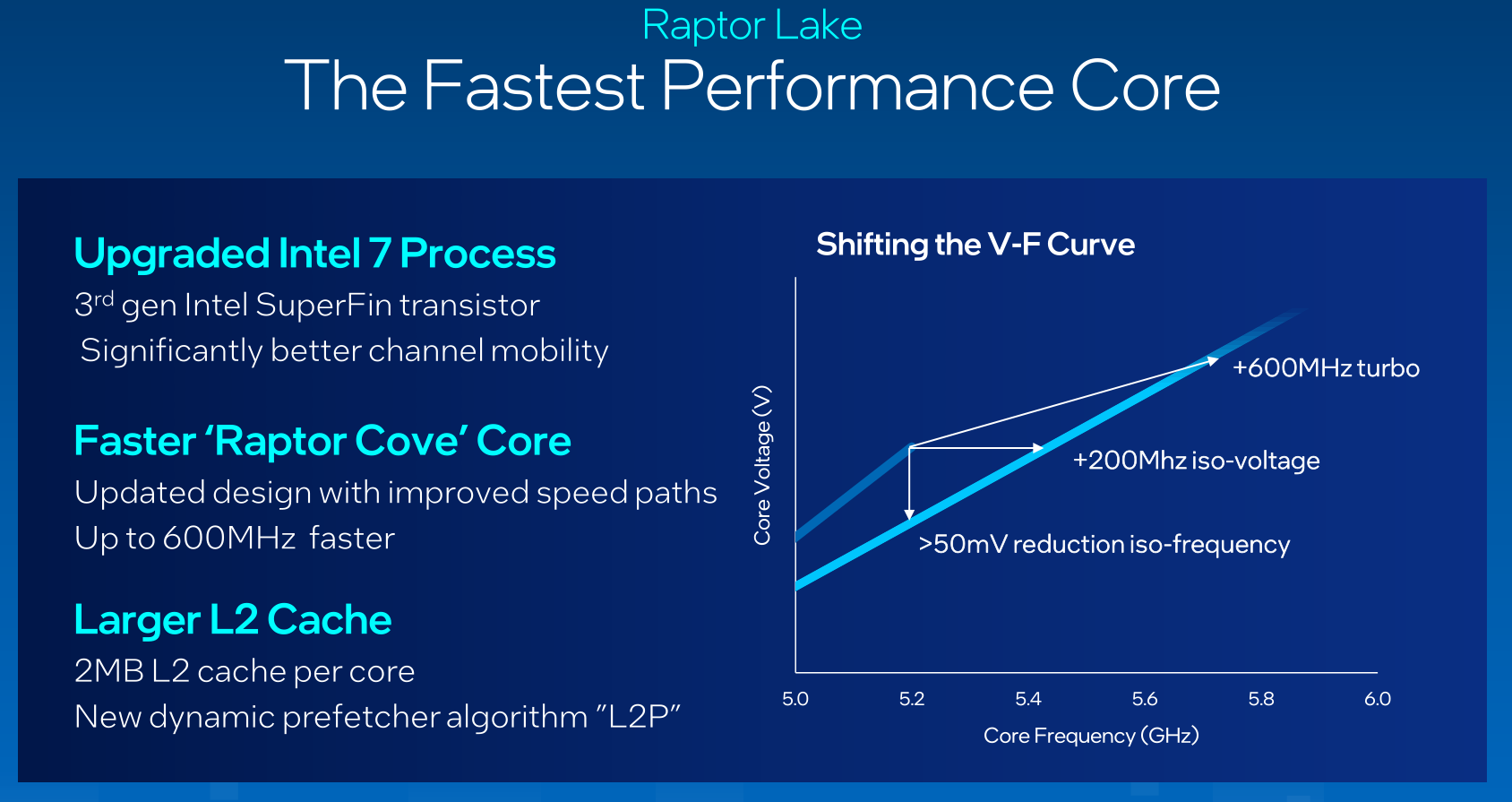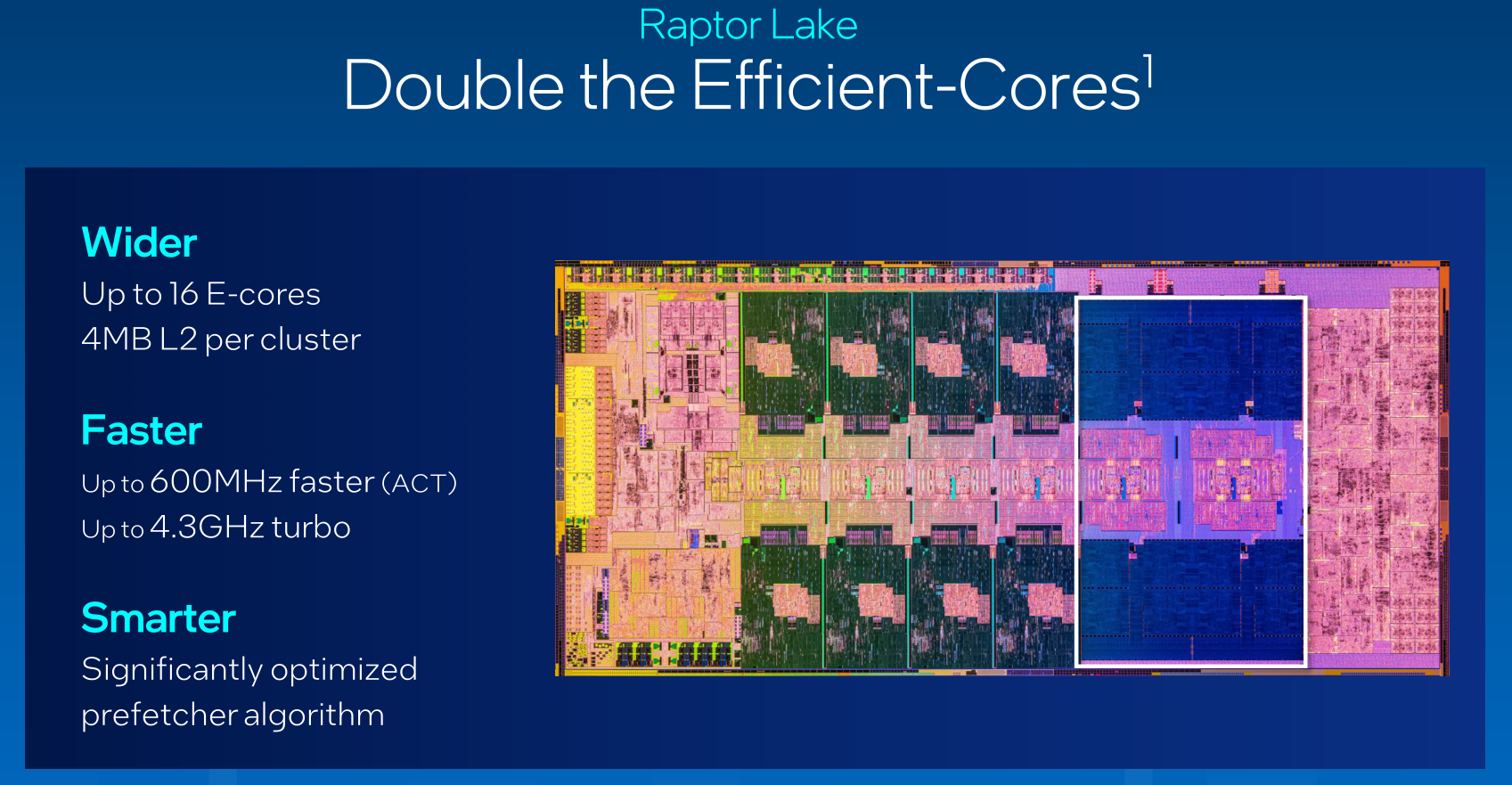Intel Core i9-13900K and i5-13600K Review: Raptor Lake Brings More Bite
by Gavin Bonshor on October 20, 2022 9:00 AM ESTRaptor Lake In Detail: Raptor Cove P-Cores, More Efficiency Cores
When it comes to architecturally dissecting the differences between Intel’s Alder Lake and Raptor Lake processors, both are based on a similar process. Intel’s 12th Gen Core (Alder Lake) series and the latest 13th Gen Core (Raptor Lake) are based on its Intel 7 manufacturing processor, although this isn’t to be confused with 7 nm, as Intel 7 is a 10 nm process node. This means that Raptor Lake isn't a new core so to speak, especially not a redesign of its existing 10ESF core, but more augmentation. Intel has opted for improvements to its underlying memory and cache structures.

Intel Raptor Lake Core die image (Core i9-13900K)
The new Raptor Cove performance (P) cores replace the previous Golden Cove variants, with Intel specifying that Raptor Cove is based on an ‘enhanced’ version of its Intel 7 process using its 3rd generation of SuperFin transistor. With this newly optimized process combined with a better overall VF curve over the last age, Intel hopes to leverage the benefit from a higher frequency without increasing power levels too much.
Focusing on changes to the cache, the 13th Gen Core series has more L2 cache. For the new Raptor Cove core, Intel has added more L2 cache when compared to Alder Lake, with 1.6x more with 2 Mb per P-core. The levels of L2 cache assigned to each array of E-cores now equates to 4 Mb; up from 2 Mb. This means Intel has improved the L2 cache on both core types. For the L3 cache, Intel hasn't made any strides and has left things unchanged.
Adjusting to the Voltage Frequency (VF) cure has allowed Intel to squeeze out even more gains about frequency versus voltage. In the case of Raptor Lake, Intel has managed to increase the peak P-Core frequency by a significant amount, up to 1 GHz in some cases. An example is the Core i9-13900K which has a maximum turbo frequency of up to 5.8 GHz; this equates to just over 11.5% over the Core i9-12900K. As per the released V/F curve optimizations, Intel has managed to eke out 200 MHz at ISO-Voltage, with a reduction of 50 mV at ISO frequency.
One thing to highlight about Intel’s 13th Gen Core series processors is the discrepancy between the base TDP, which for its entire launched stack (as of 10/20) is 125 W. The turbo or PL2 values are the same for the Core i9 and Core i7 models which are set at 253 W. This is an increase of 12 W from the corresponding 12th Gen Core i9 chips (241 W), and up by 63 W on the Core i5 series like for like. With the element of adding double the amount of E-cores, even with a more efficient V/F curve, there had to be tradeoffs when it came to power.
Raptor Lake and E-Cores: Same Gracemont Cores, Just More of Them
As we reviewed the previous generations of Intel Core i9-12900K processors, Intel has kept the same Gracemont-based Efficiency (E) core for Raptor Lake. The key difference when comparing the flagships of both generations, the Core i9-13900K has double the amount of E-cores compared to the previous generation. The doubling of E-cores in combination with the refined Raptor Cove core design for the P-cores means that the Core i9-13900K now has a total of 24-cores, with other SKUs benefitting from an increase in E-cores too.
Still, even with double the E-cores, the power penalty for doing this shouldn’t be an issue, at least not from a cooling perspective. As is with a high-performance processor and the high PL1/PL2 power it needs to stretch its legs, premium cooling would never go a miss. Intel isn’t officially recommending a minimum limit to cooling, but a low-performance cooler will almost guarantee thermal throttling as the Thermal Velocity Boost (TVB) for 13th Gen is set to 70°C.
In addition to the changes above, Intel’s 13th Gen Core series (unlike AMD’s Zen 4) offers support for both DDR5 and DDR4 memory. Further to the previous 12th Gen, the 13th Gen now supports faster DDR5 memory (DDR5-5600 versus DDR5-4800), an increase of 16.6%. Bandwidth and speeds for DDR4 memory remain at 3200 MT/s. Still, it allows users to match a lower-value processor without paying over the odds for DDR5 memory, which should decrease in price over time (hopefully).
Intel Thread Director: Windows 11 22H2 (or Newer) is Recommended
Since Intel’s 12th Gen Core series launch late last year, there was much furor around task scheduling in combination with Intel’s (new at the time) Thread Director built into the cores. While there were clear issues with Thread Director in combination with Windows 10, the Windows 11 operating system alleviated the issue of parking high single-threaded workloads on cores that otherwise wouldn’t be the best option (E-Cores). Although Windows 10 did in essence work with Intel Thread Director, it wasn’t really good at highlighting efficiency, and this is where Windows 11 came into play for optimal performance with Alder Lake.
Fast forward to now, and with all the additional E-cores in play with Raptor Lake, the latest update at the time of writing, Windows 11 22H2, offers the latest enhancements in the partnership between Intel, Microsoft, and the inner workings of Intel’s Thread Director. With a hybrid architecture and non-optimized software, it makes things a bit of a mess, but as per Intel’s guidance, they do recommend users use Windows 11 with 22H2 (or newer) for optimum performance when using 13th Gen Core series processors.
Over the next page is more information about the latest Z790 chipset which accompanies the Raptor Lake processors with this launch. From then on in, we'll detail our new CPU suite for 2023 and beyond, as well as see if Intel's 13th Gen Core Raptor Lake series can take a bite out of the competition. The associated pages and their contents are highlighted below:












169 Comments
View All Comments
Bruzzone - Friday, October 21, 2022 - link
Raptor ask first day in the open market;13900K = $845 + 43% over i$1K
13900KF = $1187 + 110%
13700K = $393 (-12.5%) some assemblance of reality in the world
13700KF = $415 + 8%
13600K = $393 + 23%
13600KF = $415 + 34%
Raphael R7K fifth week of supply open market;
7950X = $933 + 33.6%
7900X = $695 + 26.6%
7700K = $477 + 19.5%
7600X = $422 + 41.3%
In July Intel signaled a +20% price increase and AMD ignored Intel counsel and the channel will settle that question by Black Friday Cybor Monday. The question has already been answered for dGPU in the market for RTX 4090?
mb Reply
Wrs - Friday, October 21, 2022 - link
That's why I usually buy new hardware a bit after Xmas. That wouldn't have worked for several reasons in 2020-21, but other years it's served me well. ReplyBruzzone - Friday, October 21, 2022 - link
Prior gen CPU and dGPU production overage run end absolutely a "bit after Christmas".New primary dGPU a Pareto distribution curve and that does not explain it the situation assessment fully for all consideration.
On new CPU production AMD ignoring Intel + 20% price increase offer it's a CPU new primary price war unless the channel disagrees bringing normalcy to cost : price / margin assessment on cost : price / margin realities.
mb Reply
Ryan Smith - Thursday, October 20, 2022 - link
Like any other CPU launch, the only prices we have at the start are the prices provided by the manufacturers. Retail prices can and will vary, especially at the very start when chips are in short supply.It's best to consider it guidance rather than hard numbers. Reply
allenb - Thursday, October 20, 2022 - link
Now this is what we want to see! Proper, vicious, dog-eat-dog competition from Intel and AMD. I've rarely seen a clearer example of why competition is good and entrenched monopolies (or near monopolies) are bad. Hats off to both competitors. ReplyOxford Guy - Friday, October 28, 2022 - link
Duopoly is hardly adequate competition. ReplySilver5urfer - Thursday, October 20, 2022 - link
I will keep it short.Buy Intel get it under AIO and get ready for 340W load on 13900K while AMD Zen 4 is at 95C but its significantly lower power at 230W only max. The flagship parts need AIOs no Air coolers, but with AMD some of the Air coolers can work without problem since the heat is only factor but not the high power as the Temp target can be set on AMD platform from 95C to 92C. Intel 12900K and up aka 13700K, 13900K cannot be tamed on Air coolers esp when you tune them. So a mild win to AMD.
The I/O is a win for Intel due to DMI is 4.0x8 while X670E is PCIe4.0x4 like X570 bummer from AMD perhaps PCIe5.0 redrivers and layers cost.
IMC wise Intel is winning, but with DDR5 in this infancy stage even buying 7000MHz low Latency DRAM won't benefit RPL at all. AMD stuck to 6000MHz EXPO why did you not review on that ? I think AT should have stuck to XMP for Intel and EXPO for AMD as AMD will have better performance with better DRAM since the Zen 2 days. Ultimately IMC is bragging right for Intel DDR5 RPL now, the socket is EOL and you cannot install new Kits and expect magic just like 8th gen vs 10th gen IMCs you will need a new Chip.
Socket is dead end for Intel nothing extra is coming, you are locked out. AM5 will get Zen 4D and Zen 5 and 5D as well. Much better longevity past 2025+ if AMD launches Zen 6 then it's insane on this AM5 socket. Also Z790 will have CPU socket bending issues note that as well.AMD wins here.
Performance wise, both are neck to neck. High clocks on both high MT workloads on both camps, this is very interesting market for R9 and i9 parts. Coming to i5 and R5 parts, Intel has more performance but AMD has better pricing. However the most parts shipped will be this range only I think Intel may win more Client sales vs AMD due to DDR4. No winner but it's a great consumer choice. One point to note, AMD has higher Base Freq vs Intel this means better performance for AMD on all workloads and not just demanding. Esp with Zen 4 which is a solid chip than Zen 3 with it's lower clocks annoying IOD crapping out and IMC being subpar.
AVX512 is dead, big shame to Intel. They are wasting 30% of the die space in the RPL processors P cores, ultimate pathetic move. AMD is a champion with dual AVX256 making it solid no AVX offset performance unlike Intel 11th and 12th gen. AMD wins here. Reply
WaltC - Thursday, October 20, 2022 - link
I hope this sad excuse from Intel shuts the facial orifices of those who thought the power draw of the 7950X was "too high"...;) These CPUs should sell well in colder climes, no doubt (for people who can afford the power bills...;)) ReplyWrs - Friday, October 21, 2022 - link
For workload efficiency it's mainly about the process tech. AMD with TSMC are at 5nm, Intel is still at 7nm (or you can say TSMC is around Intel's 7nm, while Intel is using its 3rd-gen 10nm).I like my P-cores on 12900k, thank you, they are the reason I didn't stick with Zen 3. A desktop computer needs to be highly responsive and it needs throughput when called for. I weigh those as 50% ST:50% MT, but everyone should personalize their ratio to what they really do. 90% ST:10% MT? Get a laptop. 10% ST:90% MT? A workstation or remote server/cloud.
I also have no issue with a D15 air cooler. The processor automatically tamps down to 250W sustained, but if I want something intense done, it'll blitz through the first second or two. As for power bill considerations, the Zen 3 did idle pretty high and I noticed. But on my desktop I rarely ever idle. It was more that a year ago, Zen 3 and Alder Lake were the same process generation, and Alder Lake hands down won the ST. Reply
yh125d - Thursday, October 20, 2022 - link
So top of the line Raptor Lake trades blows/equals on average to Zen 4. But only if you have a motherboard/cooler capable of delivering and cooling 300+w, which means top of the line hardware. By the time you factor in the cost of a top notch MB and 360 AIO, you erase the price advantage of the processor itself.Limit i9 to similar power levels, and the performance would reduce more than just a few % I'd wager, so for those sticking with air cooling or smaller AIO's, Zen 4 has a clear advantage. This also points out that Raptor Lake doesn't have much headroom above this to go, where Zen 4 (if allowed 250w+) would clearly outperform RL at same power levels
Overall, this generation is much closer than I'd thought it would be, which as always is great for consumers Reply